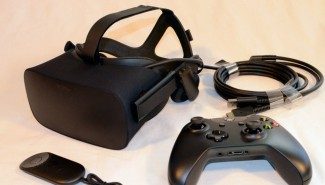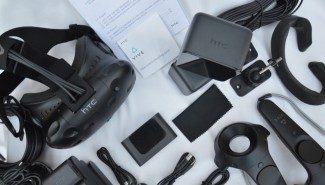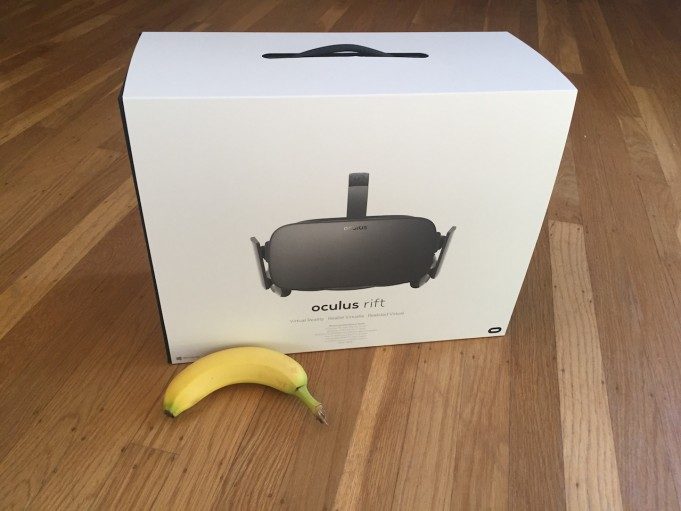I have a confession to make: my Rift CV1 arrived two weeks ago and I only just opened it. You see… I was busy the night it arrived, and then the next day the Vive arrived, and it has room-scale, so I set that up, and it’s super fun, and maybe Vive is all I need, and what if instead of unboxing my Rift I just sell it instead?

Are these the actions of a mad man? Perhaps. If you told me a year ago that not only would I not rip my Rift open immediately but that I’d consider leaving it unopened altogether, I’d have told you you’re out of your mind. And yet here we are. How did this happen?
For me, there were a few contributing factors. And bear in mind that some of these are the expression of personal preferences, that different people like different things, and all that.
Room-scale: For me, room-scale tracking of head and hands is “next level” VR, and the Vive has this in spades. A large portion of floor space in my two car garage has been cleared off and made available for VR fun times. Using a garage for VR probably isn’t ideal for many who live outside of Northern California — I know when I lived in Florida I would’ve succumbed to heat stroke in about 20 minutes — but you can pull it off here comfortably maybe 9 months out of the year. Valve’s Chaperone system provides peace of mind that I won’t smash the washing machine or tumble over the treadmill. There’s enough flexibility in the lighthouse system that I was able to place base stations near power outlets while still providing full coverage.
Steam integration: As a platform for finding, purchasing, installing, and playing games, Steam is unparalleled. Others have tried to replicate its success, with mixed results. I have my own issues with how the Steam Store is laid out, but it doesn’t seem to be hampering sales, otherwise Valve would dig into the user experience and make improvements. Valve has done a great job of blending “flat” and VR to reduce much of the friction in getting players into and out of VR.

Developers: A key reason HTC/Valve had a decent number of launch titles is they were generous in who they anointed with early hardware. While some developers may have had complaints around when they received their kits, most of the devs I know did receive them and started to work on either adapting their existing games to Vive or trying new things. And my personal experience with developer hardware support was great: emailed Support at 3pm that one of the base stations was malfunctioning, had a brand new one in my hands by 10am the next morning. That’s an Amazonian level of turnaround, though I’ve heard of at least one instance where this was not the case with the consumer version.
Disclosure: As far as I’m aware, HTC/Valve had no restrictions in place on telling the world you had the headset. At the other end of the spectrum, Oculus developers were tied to an NDA that not only kept you from posting photos or videos of you enjoying the Rift, but prevented you from even acknowledging you possessed one. Happy Vive developers posted photos and videos on Facebook, Twitter, YouTube, Google+ (just kidding), Snapchat, and beyond, which helped drive interest. It’s hard to know for sure whether these divergent approaches — Oculus closed, Valve open — had a measurable impact on actual sales, but I feel confident saying Valve’s policy allowed them to catch up significantly to Oculus despite releasing their dev kit much later.
I relented and opened the Rift three nights ago. There are a few Oculus-exclusive titles I was itching to play, mainly The Climb, Lucky’s Tale, Eve:Valkyrie, and Chronos. After two hours on the evening I unboxed it and another hour the next day, I unplugged the Rift and set the Vive back up. The simple fact is that room-scale is essential to me, and while it appears to be technically possible with the Rift, Oculus has been public about focusing on seated or limited standing experiences. Vive ships with the capability to track head and hands in a ~ 15′ x 15′ space. Oculus ships with positional head tracking only. Touch controllers will ship later this year, and we expect Oculus will offer the option to add another sensor for room scale, but as of right now, May of 2016, this is the apples-to-apples comparison of shipping consumer VR products.
The question you should ask is what matters to you, and make the best selection based on how you play. Room scale? Vive. Lighter headset? Oculus. Hand tracking (even if it’s a sometimes-awkward stick)? Vive. Willing to wait for a slick controller that wraps around your hand? Touch. Bad ass space pirate ninja moves? Vive. Gorgeous-looking multiplayer galactic battles in your own spaceship? Oculus. You get the idea.
For every room-scaler like me, there’s someone who wants to just sit and chill. The best thing about competition is that it offers us choice. What do you choose?
Follow Brian on Twitter at @vr_bhart.







